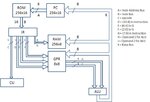Zerox100
Full Member level 6
Hi,
Is there any high level VHDL code that easily synthesized to a ROM in BRAM. I am working on a project and i need a 65536 single bit ROM in a Spartan-iii FPGA. I can use core generator, But i think it should be very good if i have a high level code that easily synthesized to ROM (a BRAM with initial value and write disabled) during synthesis process. Is it possible?
Is there any high level VHDL code that easily synthesized to a ROM in BRAM. I am working on a project and i need a 65536 single bit ROM in a Spartan-iii FPGA. I can use core generator, But i think it should be very good if i have a high level code that easily synthesized to ROM (a BRAM with initial value and write disabled) during synthesis process. Is it possible?
